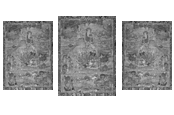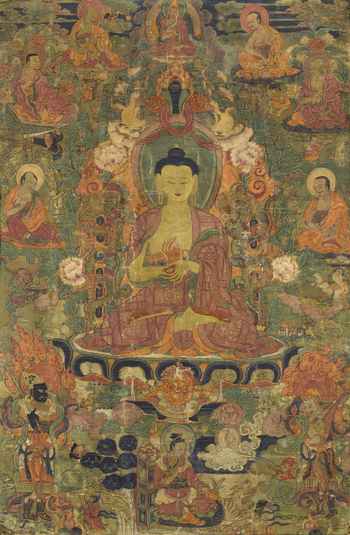
Item: Dipamkara Buddha - (Seated)
| Origin Location | Tibet |
|---|---|
| Date Range | 1700 - 1799 |
| Lineages | Gelug and Buddhist |
| Material | Ground Mineral Pigment on Cotton |
| Collection | Private |
Classification: Deity
Appearance: Buddha
Gender: Male
Dipamkara Buddha, the Buddha of the Past.

The central figure in this composition is identified as Dipamkara Buddha because it belongs to a set of paintings depicting Shakyamuni Buddha and the Sixteen Great Elders. This information is known by identifying the figures in the composition: six elders, one attendant (Dharmatala), and two Direction Kings. There is no tradition or precedent for creating a composition with this random selection of figures. The Subjects of Shakyamuni Buddha and the Sixteen Great Elders is the most basic and the first of the common iconographic number sets.
In the Mahayana tradition of Buddhism it is popular to include the Buddhas of the Three Times either at the top of a single composition or as the central figures in a set of three paintings.
This is the 2nd painting in a set of three paintings depicting Shakyamuni Buddha and the Sixteen Elders. Each of the three compositions has the central figure as one of the Buddhas of the Three Times. This composition is not the last in the set of three which would depict Maitreya the Future Buddha, Hvashang and Vaishravana. It is also not the first composition which would depict Shakyamuni and his two principal disciples, therefore this painting must be the 2nd composition depicting the Dipamkara - the previous Buddha.
Jeff Watt 2-2018
Collection: Bonhams NY, March 2018
Buddhist Deity: Dipamkara Buddha

